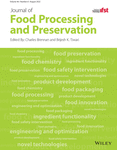Experimental study of solar drying of multi-layer peanuts and development of drying model
Abstract
An experimental study is performed on a natural convection solar dryer on Indian peanuts for multi-layer drying behavior. The solar air dryer developed and employed in this study has parallel flow, single pass with a flat surface design. It has an orientation system to enhance energy gain of the heated air. The present study was aimed to obtain drying characteristics of multi-layer peanuts and thereby developing an empirical model for moisture ratio prediction. It was observed that the thermal efficiency of the dryer decreases over consecutive days of drying while specific energy consumption increases. The effective moisture diffusivity of 6.3927 m2/s × 10−10 m2/s and 2.9225 m2/s × 10−10 m2/s for the thin layer and four-layer peanuts, respectively, was obtained indicating a decrease with multi-layer. Experimental results showed very good agreement with Midilli and Kucuk model for thin layer drying. A new drying model has been proposed for the prediction of drying characteristics of multi-layer peanuts (shelled peanuts), and the same is validated with the experimental findings.
Novelty impact statement
Drying peanuts in a natural convection solar dryer is one of the simplest processes available to farmers and domestic users. Peanuts have a high content of oil, protein, and nutrients content and is used all over the world throughout the year. During drying of peanuts, the moisture content is reduced to ensure safe moisture content, resulting in a less postharvest loss. The quality of dried peanuts is of great importance to ensure a long shelf life. The purpose of this article was to reduce the drying time in natural convection solar dryer by using the multi-layer drying concept and providing a proposed model for optimum drying. The finding of this study will be useful in reducing drying time, improving product quality, and avoiding product degradation. The obtained results also provide a practical alternative to the existing conventional drying system that is used in the field for postharvest thermal treatment of peanuts.
Open Research
DATA AVAILABILITY STATEMENT
The data that support the findings of this study are available on request from the corresponding author. The data are not publicly available due to privacy or ethical restrictions.




